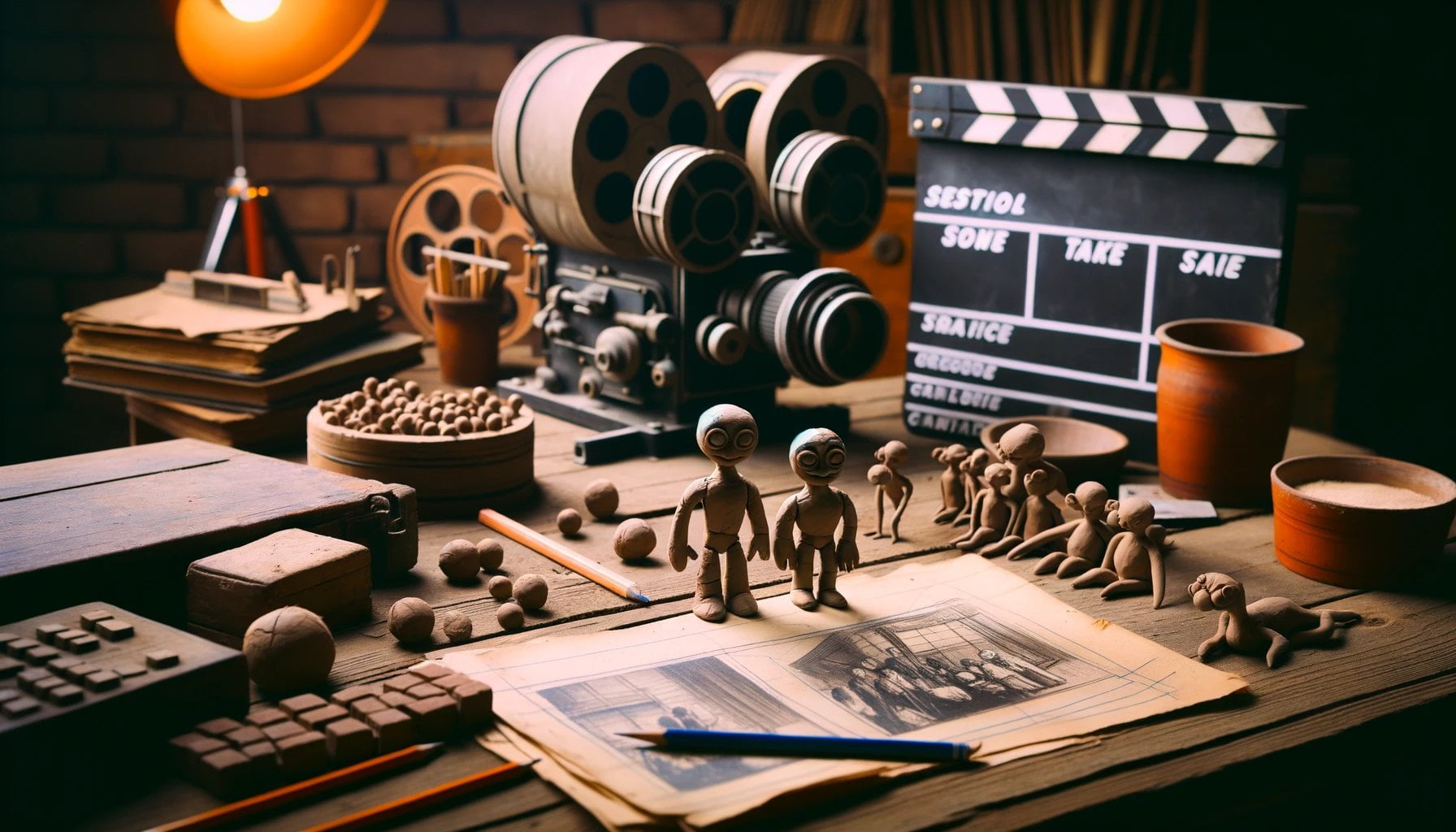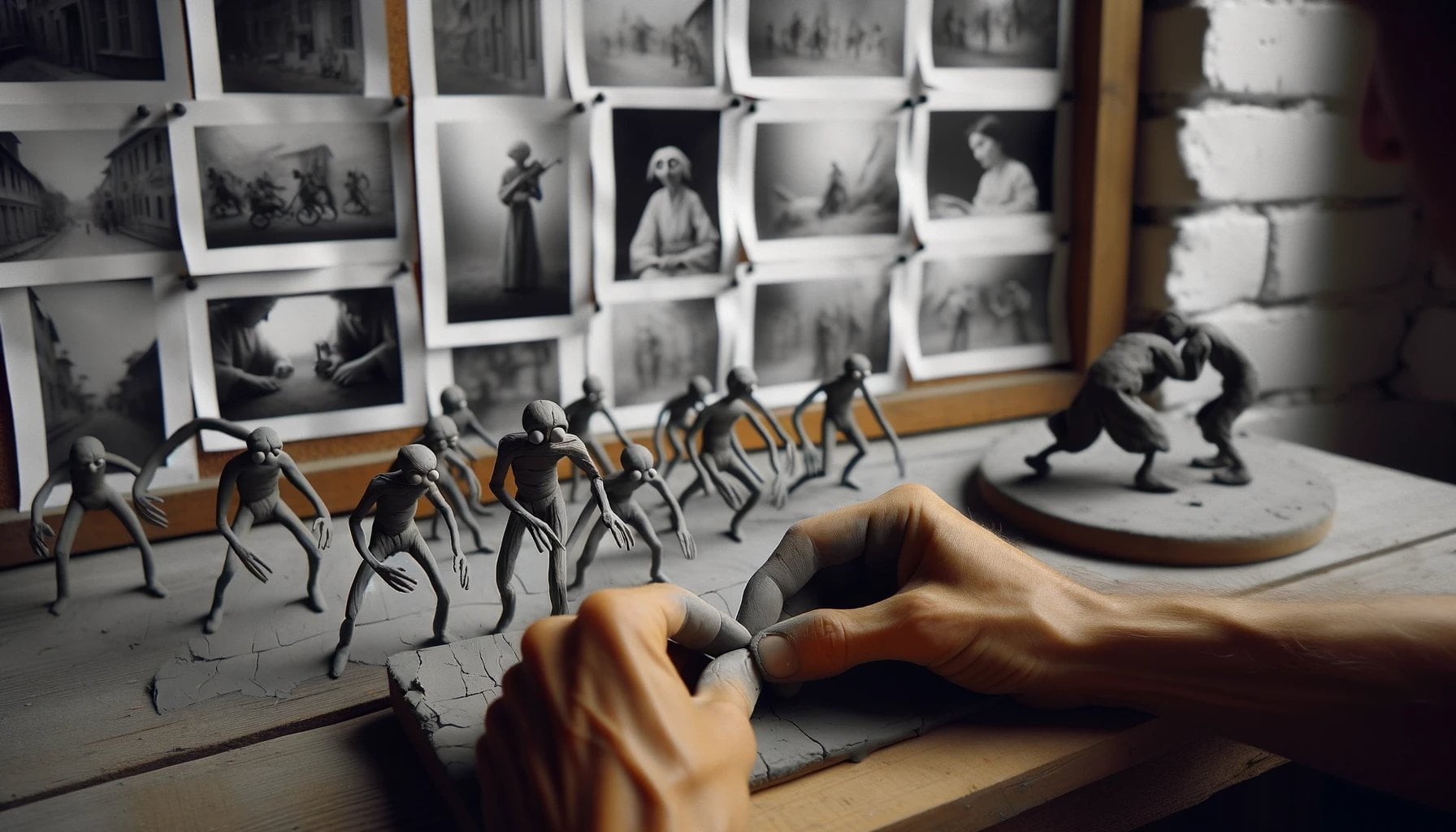Welcome to the fascinating world of clay animation history! In this article, we will delve into the captivating realm of clay animation, unearthing its remarkable milestones, groundbreaking techniques, and influential figures. Join us on this journey as we explore the rich tapestry of clay animation’s evolution, showcasing the ingenious creativity that has shaped this unique form of filmmaking. From the early beginnings to the modern advancements, we will uncover the intricate details and captivating stories behind this extraordinary art form. So sit back, relax, and prepare to be mesmerized by the mesmerizing history of clay animation.

Key Takeaways:
- Clay animation is a form of stop-motion animation using 3D models sculpted from oil-based modeling clay.
- The first clay animation films date back to 1908, making clay animation a century-old technique.
- The term “Claymation” was coined and trademarked by Will Vinton, who created a documentary showcasing his innovative clay animation process.
- Plasticine, an oil-based modeling clay, was developed in 1897 and became a popular material for clay animation.
- Clay animation has played a significant role in the history of animation, from its invention to modern-day works by top animation studios.
- The resurgence of clay animation happened in the 1980s, with more studios embracing the tactile nature of the medium.
- Notable clay animation films include “Chicken Run” and those by Nick Park and Peter Lord.
- Clay animation involves creating movable clay figures and capturing each movement frame by frame to create the illusion of motion.
- Will Vinton’s clay animation film “Closed Mondays” won the Academy Award for Best Animated Short in 1975.
- The early history of clay animation has been overshadowed by the development of animated cartoons, receiving little attention.
Clay Animation History
Clay animation, a captivating form of stop-motion animation using oil-based modeling clay, has a rich and influential history spanning over a century. Unveiling the development and evolution of this unique art form allows us to appreciate the milestones, techniques, and influential figures that have shaped clay animation history.
The Origins of Clay Animation
In 1908, the world witnessed the birth of clay animation with the first clay animation films created. Since then, this captivating form of animation has continued to grow and captivate audiences with its tactile and immersive nature. The term “Claymation,” coined and trademarked by the visionary animator Will Vinton, perfectly encapsulates the essence of this art form.
Exploring Clay Animation Techniques
To truly understand the artistry behind clay animation, it is essential to delve into the techniques used to bring clay figures to life. This intriguing process involves sculpting 3D models using oil-based modeling clay, also known as plasticine. Each movement is carefully captured frame by frame, creating the illusion of motion. It requires meticulous attention to detail and patience, resulting in mesmerizing and engaging animations.
Clay animation’s resurgence occurred in the 1980s when studios started recognizing the unique possibilities offered by this medium. The tactile nature of clay allowed animators to infuse their creations with a remarkable sense of depth and realism. The medium’s versatility opened up new avenues for storytelling, captivating audiences worldwide.
Notable Figures in Clay Animation
Throughout clay animation history, several notable figures have made significant contributions to the development and popularization of the art form. Will Vinton, often referred to as the “Godfather of Claymation,” brought clay animation to the forefront with his groundbreaking techniques and innovative storytelling. He won acclaim and the Academy Award for Best Animated Short in 1975 with his film “Closed Mondays.”
Other influential figures such as Nick Park and Peter Lord, co-founders of Aardman Animations, have also left an indelible mark on clay animation history. Their remarkable creations, including the beloved characters Wallace and Gromit, showcase the immense talent and creativity within the clay animation realm.
Clay Animation’s Impact on the Animation Industry
While clay animation has sometimes remained in the shadow of animated cartoons, its contributions to the animation industry are impossible to overlook. From its humble beginnings to modern-day works by top animation studios, clay animation has played a vital role in pushing the boundaries of what is possible in animation.
Despite the lack of historical attention, clay animation has continued to evolve and thrive, showcasing its lasting impact on the art form. Films like the acclaimed “Chicken Run” highlight the artistry and charm that clay animation brings to the big screen.
Unearthing Clay Animation History
Clay animation history is a treasure trove waiting to be explored. From its inception over a century ago to its ongoing influence on animation today, understanding the art form’s milestones, techniques, and influential figures allows us to appreciate the immense creativity and dedication behind clay animation.
As we navigate through the fascinating history of clay animation, we unlock a world of wonder and innovation. Join us on this adventure as we delve into the details that have shaped clay animation into the captivating art form it is today.
Animation history has always fascinated people with its evolution and impact on the entertainment industry. Dive into the intriguing world of animation history by clicking on this animation history link and unraveling the secrets behind your favorite animated films and characters.
Evolution and Popularization of Clay Animation through Influential Films
Clay animation, also known as claymation, has a captivating history that has extended over a century. This unique form of stop-motion animation involves the use of Plasticine clay models, meticulously sculpted and manipulated to create lifelike movements and stories. Through influential films and dedicated animators, clay animation has evolved and become a beloved art form within the animation industry.
Origins and Milestones
The journey of clay animation began in 1908 when the first clay animation films emerged. These early films, though simple compared to the intricate creations of today, laid the foundation for the art form’s development. However, it wasn’t until the term “Claymation” was coined and trademarked by animator Will Vinton in 1976 that clay animation gained widespread recognition.
Techniques and Techniques
Claymation requires a great deal of patience, skill, and attention to detail. Animators meticulously shape and mold the clay models, bringing them to life through the process of stop-motion animation. Each subtle movement is captured frame by frame, resulting in the illusion of smooth motion. This laborious process showcases the immense creativity and dedication behind clay animation.
Influential Figures
Throughout its history, clay animation has been influenced and shaped by notable figures. Will Vinton, the pioneer of Claymation, played a significant role in popularizing the art form. His creative vision and experimentation pushed the boundaries of what clay animation could achieve. Additionally, animators like Nick Park and Peter Lord have made substantial contributions to the industry, with films like “Chicken Run” captivating audiences and highlighting the versatility of clay animation.
The Popularization and Impact
As clay animation evolved, it gained popularity for its unique storytelling capabilities and realism. In the 1980s, a resurgence in the art form occurred, drawing attention to the immense possibilities clay animation offered. Despite sometimes being overshadowed by traditional animated cartoons, clay animation continued to thrive, captivating audiences with its distinctive charm and tactile aesthetic.
Key Takeaways:
- Clay animation, or claymation, traces its origins back to the early 1900s and has a rich and influential history spanning over a century.
- The term “Claymation” was coined and trademarked by Will Vinton, an animator who played a significant role in popularizing clay animation.
- Clay animation involves the meticulous sculpting of clay models and capturing each movement frame by frame through the laborious process of stop-motion animation.
- Notable figures like Will Vinton, Nick Park, and Peter Lord have shaped the evolution of clay animation through their innovative and creative contributions.
- Despite sometimes being overshadowed, clay animation continues to captivate audiences with its unique storytelling capabilities and tactile aesthetic.
In summary, clay animation has come a long way since its inception in 1908. Through the evolution of techniques, influential films, and the dedication of talented animators, clay animation has carved its place in the history of animation as a beloved and influential art form.
Impact of Technological Advancements on Clay Animation
Key Takeaways:
– Technological advancements have greatly influenced the evolution of clay animation, enhancing the creative possibilities and efficiency of the art form.
– The introduction of digital technology has revolutionized the way clay animation is produced, making it more accessible to a wider audience.
– Computer-generated imagery (CGI) has enabled seamless integration of clay animation with other forms of animation, resulting in visually stunning and captivating films.
– The use of 3D modeling software and 3D printers has made it easier to create intricate clay models with different textures and details.
– The advent of digital cameras and editing software has streamlined the production process, allowing for precise control and manipulation of frames.
– Clay animation techniques have adapted to utilize green screens and motion capture technology, extending the possibilities for storytelling and special effects.
– The rise of online platforms and streaming services has provided clay animators with new avenues to showcase their work and reach a global audience.
– Technological advancements have also improved the preservation and restoration of clay animation classics, ensuring the longevity of these influential works.
Unleashing Creative Possibilities through Technology
As clay animation continues to captivate audiences with its distinct tactile aesthetic, technological advancements have played a significant role in pushing the boundaries of this art form. The impact of these advancements on clay animation has been far-reaching, providing animators with enhanced tools and techniques to bring their imagination to life on the big screen.
Seamless Integration with CGI
One of the most notable developments in clay animation has been the integration of computer-generated imagery (CGI). This fusion of traditional clay animation with digital technology has resulted in visually exquisite films that push the boundaries of storytelling and creativity. Through the seamless integration of CGI and clay animation, animators can create breathtaking worlds, rich in texture and depth.
Enhanced Model Creation Techniques
Technological advancements have also paved the way for more efficient and intricate model creation. The introduction of 3D modeling software and 3D printers has revolutionized the clay animation process, enabling animators to sculpt detailed and lifelike characters with ease. From the smoothness of features to the intricate texture of clothing, the use of these technologies allows for a level of detail that was previously unimaginable.
Streamlined Production Process
Gone are the days of laboriously capturing each movement frame by frame using traditional cameras. The advent of digital cameras and editing software has streamlined the production process for clay animation. Animators can now instantly review and manipulate frames, ensuring greater precision and control over the final result. This digital revolution has not only increased efficiency but has also expanded the horizons of storytelling in clay animation.
Expanding Possibilities with Greenscreens and Motion Capture
Technological advancements have not only improved the creation process but have also expanded the possibilities for storytelling and special effects in clay animation. Greenscreen technology allows clay animators to seamlessly integrate their characters into any environment, transporting audiences to fantastical worlds and exotic locations. Motion capture technology has revolutionized the way clay characters move, enhancing the realism and fluidity of their animation.
Showcasing and Preserving Clay Animation
Technological advancements have also provided new platforms and avenues for clay animators to showcase their work. Online platforms and streaming services have made it easier than ever for clay animation to reach a global audience. In addition to increased exposure, technology has also improved the preservation and restoration of clay animation classics. Through digitization and restoration techniques, these timeless works can be enjoyed by current and future generations.
The impact of technological advancements on clay animation cannot be understated. From enhanced model creation techniques to streamlining the production process and expanding storytelling possibilities, technology has propelled clay animation into new realms of creativity and accessibility. As the art form continues to evolve, we can expect technology to play an even more significant role in shaping its future.
Contemporary Clay Animation and Its Relevance in the Digital Age
Clay animation, also known as Claymation, has a rich history spanning over a century. From its inception in 1908 with films like “The Sculptor’s Welsh Rarebit Dream” and “The Sculptor’s Nightmare,” clay animation has evolved and made significant contributions to the animation industry. Notable figures like Will Vinton, Nick Park, and Peter Lord have pushed the boundaries of clay animation, showcasing its immense creativity and dedication.
While clay animation has experienced ups and downs in popularity, it has managed to captivate audiences with its unique charm and tactile aesthetic. In the 1980s, it saw a resurgence due to its storytelling capabilities and realism. Yet, despite occasional overshadowing by more traditional animated cartoons, clay animation has continued to evolve and thrive.
Technological advancements have played a crucial role in shaping contemporary clay animation. The digital age has brought significant changes to the production process, making clay animation more accessible and enhancing its creative possibilities. Digital cameras, editing software, and 3D modeling technology have streamlined production, enabling precise control and manipulation of frames. Clay animation techniques now make use of green screens and motion capture, extending storytelling and special effects possibilities.
Moreover, the integration of CGI with clay animation has resulted in visually stunning films, as clay models seamlessly blend with other forms of animation. This combination of traditional craftsmanship and digital innovation has widened the potential for clay animation in the digital age.
Another noteworthy aspect of contemporary clay animation is its online presence. Online platforms and streaming services have opened new avenues for clay animators to showcase their work to a wider audience. This accessibility has allowed clay animation to flourish and gain recognition in the digital realm.
Contemporary clay animation continues to prove its relevance in the digital age by adapting to new technologies while maintaining its unique artistic appeal. Its combination of tactile charm and technological advancements make it a valuable and enduring form of animation.
Key Takeaways:
- Clay animation has a rich history dating back to 1908 and has experienced various periods of popularity.
- Notable figures like Will Vinton, Nick Park, and Peter Lord have contributed significantly to the evolution of clay animation.
- Technological advancements in the digital age have improved the production process and expanded creative possibilities.
- The integration of CGI with clay animation has resulted in visually stunning films.
- Online platforms and streaming services have provided clay animators with new avenues to showcase their work.
- Contemporary clay animation continues to adapt and thrive, showcasing its artistic appeal and relevance in the digital age.

FAQ
Q1: What is clay animation?
A1: Clay animation is a form of stop-motion animation using 3D models sculpted from oil-based modeling clay.
Q2: How long has clay animation been around?
A2: Clay animation has been around for 107 years, with the first clay animation films dating back to 1908.
Q3: Who coined the term “Claymation”?
A3: The term “Claymation” was coined and trademarked by Will Vinton to describe his own style of clay animation.
Q4: What are some notable clay animation films?
A4: Some notable clay animation films include “Chicken Run” and those created by Nick Park and Peter Lord.
Q5: How is clay animation created?
A5: Clay animation involves creating movable clay figures and capturing each movement frame by frame to create the illusion of motion.
- SYBAU See You Baby Meaning: Gen Z Slang Evolves - July 1, 2025
- Unlock Your Inner Youth: Lifestyle Secrets for a Vibrant Life - July 1, 2025
- Decode SYBAU Meaning: Gen Z Slang Explained - July 1, 2025






